I love buying bread books in all languages, the most inexpensive way of virtual travels and experience for me. I came across a book by Swedish baker and owner of Brunkebergs Bageri (Brunkebergs Bakery) in Stockholm, Heléne Johansson's[i] Bröd, Från Brunkebergs Bageri [/i]([i]Bread, from Brunkebergs Bakery[/i]). Her love and passion for bread exudes from the book. For the first 15 pages of the book on the web, please click [b]here[/b] (sorry, her serious breads are not on these first 15 pages). The book says she has used each recipe thousands of times. Her range of breads depends on "how her own spirit falling on," she says.
What attracts me is her gutsy bold style of baking. Every one of her bakes in the book looks to me a rustic beauty, not dainty, but extraordinary. I find her spirit exhilarating.
The purpose of this post is twofold:
(1) to see if I can do the same with my oven; and
(2) to experiment with the Australian "plain flour."
Like many home bakers who have come from a pastry background before taking on bread, I had steered clear of pastry flour and had developed a blind faith in bread flour. I was scare to touch lower gluten flour. In Australia, there are two types of pastry flour - plain flour and self-raising flour. I am told that plain flour is equivalent to the American all-purpose flour. However, the typical protein level of plain flour is 9.1 - 10.1% whereas the American all-purpose flour, using King Arthur's as an example, has a much higher protein of 11.7% (but I do not know if I am comparing protein at equal basis). I guess the important difference to me is that KA's all-purpose flour is made from hard winter wheat, but the Australian plain flour, being essentially used for pastry baking, comes from soft wheat. On protein alone, the plain flour is closer to the French T55 flour than all-purpose flour. When I was deciding whether or not to go ahead with my experiment, I saw rossnroller's gorgeous[b] Pain de Campagne [/b]on Sourdough.com, which used plain flour in place of all-purpose flour. That was about a month ago. I decided then that no theory or technical knowledge is better than hands-on experience.
Now, scroll forward a month later. I am happy to report that (A) the plain flour can do the job; but (B) I suspect that the plain flour is designed to accompany a lot of enrichments (butter, sugar, and many other add-in's) because on its own it does not have [b]a fermentable quality[/b] like proper bread flour. The analogy is rice. The Japanese rice and the Taiwanese rice (see, I am biased) can be eaten on its own, but other rice, especially the Thai and all other long-grain rice, is dry in its intrinsic quality and is to be eaten with a lot of gravy, eg. curry sauce, because it cannot stand on its own.
So, that's it for me with the plain flour. Go back to my bread flour.
And, as far as bold and gutsy baking goes, the following is as much as I could get with my oven:
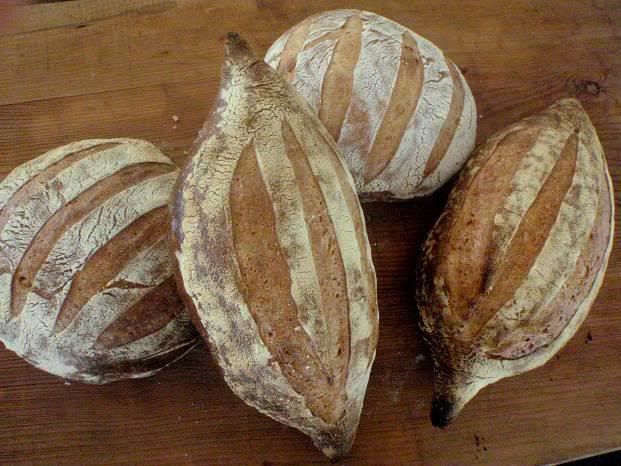
Because of the way my fan oven sends out heat, it did no good if I just turned up the heat - I got burned pointy toes and not nearly as brown on the top as on the sides of the bread as below:

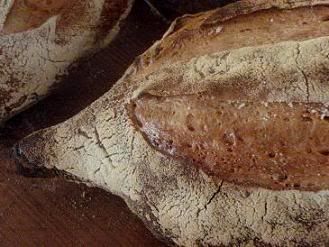
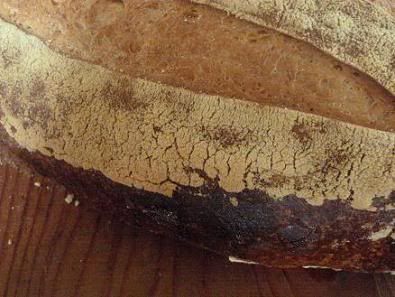
I tried to position my baking stone in a different spot in the middle of my oven but it didn't seem to make any difference. When I was at the beach duing our Christmas holiday, the oven in the unit came with top heat as well as bottom heat. It browned the top of the dough beautifully and easily.
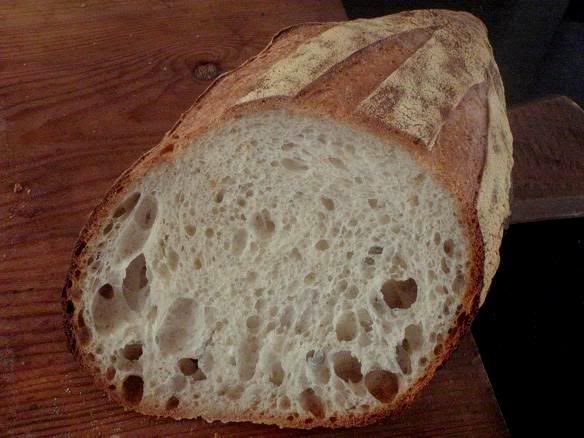
I enjoyed my bread just the same. This batch of bread had 3% rye and 7% WW in both levain and final dough. The stiff levain was built in two stages. The overall dough hydration was 69% (including 3% olive oil).

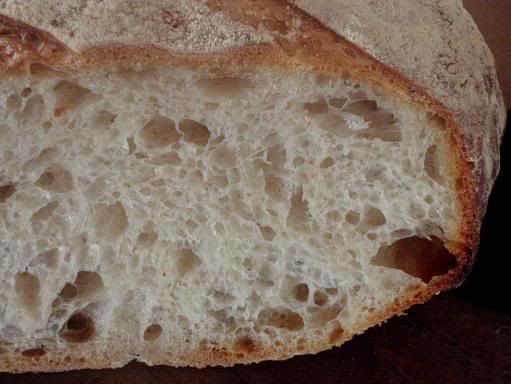
If I ever get a new oven, I would like one with separate heating elements for the top and the bottom, and I would like an in-built digital temperature reader. (I am not greedy.) But I know, the day I get the gadget perfected is the day I drop the incentive to baking to perfection. (So, it's best that I don't get it.)
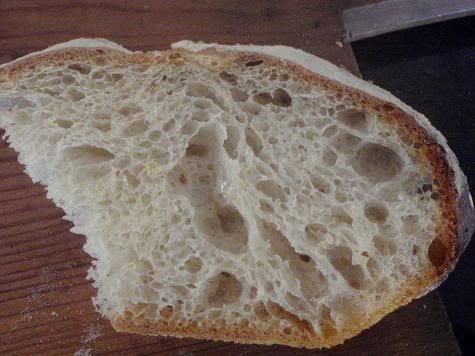
Shiao-Ping
- Shiao-Ping's Blog
- Log in or register to post comments
I rather like the rustic look of oval loaves.
The "toes" may be burning just because they are thinner and lose their water faster, thus lack cooling from evaporation.
Have you tried rotating the loaves during the bake? Does it help?
David
What that did was the round sides were evenly charcoaled. This batch was the first of about four batches that I did for the same attempt. I give up now.
Thanks, David.
Shiao-Ping
"I give up now."
What were you trying to do? They look great! The darker ends don't bother me one little bit!
If the browning was the problem, what about adding some malt? Then it will brown faster at lower temps. What about "broiling" them at the end of the bake?
Mini
That's funny (but not as silly as it sounds). Yes, I can try that. Thanks. I knew I could count on you! I fancy darker color on the top of my loaves.
Shiao-Ping
What lovely shapes and beautiful crust and crumb.
It's so refreshing to see the new breads, information and formulas you bring to TFL. You have brought so many and they are beautiful!
One way you can keep the ends from getting overly dark...which I don't mind and actually like the look...would be to cover them later in the bake with little bits of tin foil.
Reading about the oven with the upper and lower burner element. Did you turn the broiler on to get the top element to come on for your baking while you were on holiday? Any oven I have had with upper and lower elements, the lower element was the only one that came on during a regular bake cycle.
Sylvia
My griller is separate from my oven and it is beneath my oven. But the oven we had on our holiday was one with broiller in the top part of the oven. I did use the setting that had both top and bottom elements on. I much prefer that to my oven at home. I know you use your wood fired oven to bake breads, but what about your regular oven?
I do almost all my breads in my indoor ovens and even pizza's for dinner. I have made very few baked breads in the wfo. I like to fire the wfo for pizza's, grilling and baking when my husband's off and not leaving in the evening for his work, there is just the two of us. The fun part is learning to do all this cooking with and without fire/coals and in sequence as the oven temperatures change. Just as I was ready to start baking after the holidays. We began having so much needed rainfall this winter. The storms were far heavier than I anticipated and some water flowed inside the oven. Now I cover the landing and doorway! Right now it's in the process of drying out and then I will start the curing process of it over again. That won't take long and the winter weather is beautiful and mild.
Sylvia
Are these smaller breads? You always get a sheen and almost translucent quality to your crumb that I really admire. I like the dark ends. Alain Ducasse serves a mini baguette in his restaurant with pointy ends that are much more charred than yours.
Don
Thanks, Shiao-Ping
Hi Shiao-Ping,
Enjoyed reading your comments on Helene Johansson´s Bread book.
I sent a link to your post to Brunkebergs Bakery (maybe you had already done so?) so they could enjoy it, too.
I live in Stockholm, so I sometimes buy my Manitoba Cream flour at Brunkeberg´s.
It is a great pleasure reading your interesting and inspiring posts and your beautiful pictures.
best regards,
Eva
that you sent my post to Brunkebergs Bakery! I hope they like it.
Thank you.
Shiao-Ping
Hi Eva,
How are you? Since you are in Stockholm, I was wondering if you can tell me how much Helene Johansson´s Bread book would cost maybe in US dollars... Please let me know. Thanks
Tim
Hi Breadbakingbass,
I checked at adlibris.com - their price is 179 SEK
bokus.com - 185 SEK
bokia.se - 197 SEK
These prices do not include shipping. I don't even know whether they ship outside Scandinavia.
One USD is around 7:50 SEK.
Hope this is of any help.
Regards,
Eva
Thanks Eva.
So the book from adlibris would be around $24.13 USD at the current exchange rate... I'm gonna PM you...
Tim
Hi Tim, the book is on Bokus page HERE. I used Google to translate Swedish to English. You click on the red color bin like thing next to the book to put the book in your shopping basket. Then, on the top of the book, you see another red button which reads "Ga till kassan" (to log in), you click on that to register a user name for the on-line book store and take it from there.... Any time I don't know what something means, I highlight that area and get translation... Another way of getting the book!
Shiao-Ping
Unfortunately it seems Bokus is having a problem getting their books through customs in the USA. They list the countries to which they do post, and provide other useful information in English:
http://www.bokus.com/cgi-bin/P_campaign_show.cgi?location=english-information-in-english
Hiya Shiao-Ping
Another interesting post - and a fine-looking bread! It's fantastic that you keep seeking out these different bakers and alerting the rest of us to them, not to mention trying your own versions of their breads and sharing your outcomes and recipes here.
As I expressed in another thread, I am enthralled by the idea that as home bakers we have access to so many 'classic' breads from all over the world, as well as the inherited knowledge behind them and the formulae and wisdom of many of the world's great bakers. I love trying my own versions of all these breads, and you are one of the folk whose research and generous sharing facilitates this.
One thing, though - I am puzzled by your comment that the Aussie plain flour, apparently lower in protein than the KA AP flour, "does not have a fermentable quality." That is not my finding at all. I use plain flour in all my starter builds, and that's at the very source of fermentation, surely? If plain flour didn't have a fermentable quality, my starters wouldn't be active and healthy and capable of giving the rise they do to my breads.
Also, I have recently discovered that using plain flour instead of bread flour in the dough gives a different quality to the finished bread that is actually pretty nice IMO - a sort of softer, spongy effect, although not wimpy soft like commercial white sliced bread. Although there is a softness, there is still good structure to the crumb. I'm not referring to pure white pain au levain and the like; rather, I'm referring to using only plain flour in breads also including wholemeal or whole-grain rye, and other gutsier flours like that.
I don't often use only plain flour as the white flour component of my doughs, however, usually combining it with premium organic bakers' flour. I like to maintain the fond delusion that this combo is closer to a French style of white flour, although I really don't have a clue about that!
I also often use only bakers' flour - I find this gives a stronger structure, and more chew. Not necessarily better than plain flour bread IMO - just different.
Flavour seems to be good, regardless of the type of white flour used. I suspect much flavour derives from the wholemeal/rye/spelt etc component, in any case...and of course, technique including extended fermentation etc.
There is no doubt, though, that the high protein bakers' flour gives a better result in pizzas, rather than a bread flour/plain flour mix.
Re your rice analogy: while it may be true that the typically short-grain Japanese rice is better as a standalone variety than Thai jasmine rice, for Thai food, with all its tantalising spicy sauces, the fragrant jasmine rice is ideal. I guess basmati is an example of a rice that has a wonderful flavour and texture and stands alone on that account, yet combines magically with Indian dishes as well - the bakers' flour of rices, perhaps! So, just as particular rice varieties suit particular cuisines, I think different flours and flour combinations suit different breads. There is certainly a valid place for plain flour in there IMO.
Whatever, it's intriguing that we have different findings on these things. I suspect that there are just about as many perspectives on all these variables of bread-baking as there are bakers!
Cheers
Ross
Thank you for your comment. It may be safe to say that all flours are "fermentable" including even rice flour and other non-gluten flours, but whether their fermentable qualities are what we want for our bread is another issue. The statement that American all-purpose flour is equivalent to our Australian plain flour is probably true, not false, in that our plain flour really can be used for "all purposes" from the finest chiffon cake down to pizza dough. I did use Woolies plain flour to make a pain au levain and found it quite okay, as indicated in my post, but not as good as the levain breads made by Laucke's bread flour. I don't exactly know if this is just my individual taste difference or it just so happened that my levain was not performing its best on that day when I was using Woolies plain flour to make bread.
Every now and then (quite often actually) we hear some millers say their flours are the best because of this and that reasons, we don't have to believe them; but when a baker from a long standing bakery tells us he only uses certain flours for making his hearth breads, I would like to listen. In France and Japan I heard that bakers work with their exclusive millers, the millers understand the bakers' needs and mill their flour accordingly; it is collaboration for a mutual goal - the best artisan bread. I would like to think flours milled this way are different from supermarket flours for "all purposes." That's all that I was trying to say.
Shiao-Ping
I'd give anything to have those burned toes.. you're either far too hard on yourself or you're kidding us all.. your bread is beautiful.
Interesting comment, Shiao-Ping, about bakers using specific millers. I found that out when I visited Nicky Giusto's Central Milling warehouse in Petaluma; their flours are milled in Logan, Utah. Acme Bakery in Berkeley/San Francisco uses their flour, which has been milled to Acme's specifications. The artisan bread flour has a high protein content, about 13-14% if I remember correctly. It is also extremely fresh, as it is no more than 14 days old when it reaches the Petaluma warehouse. Compare that with the "use by" dates on the store packages! When I baked with it instead of my usual grocery store brand, the difference in flavor was incredible. Fresh is fresh!
Joyful
Hi diah, sorry I only have one video which my daughter took of me in May of last year, doing Richard Berstein impression of flip-and-flap "French" fold, which lasts no more than 30 seconds. It would be embarrassing to show it.
Hi joyful baker, yes, fresh is fresh, when the ingredients are fresh,and the bread is freshly baked, what else can beat the bread that comes out of our kitchen!
Hi Belle AZ, I do have good days and bad days.
Well, from your subscriptions here and posts.. I'd say you have more good than bad. You do have a good eye for baking and what you produce from a home oven is very impressive.
How long have you been "seriously" baking?